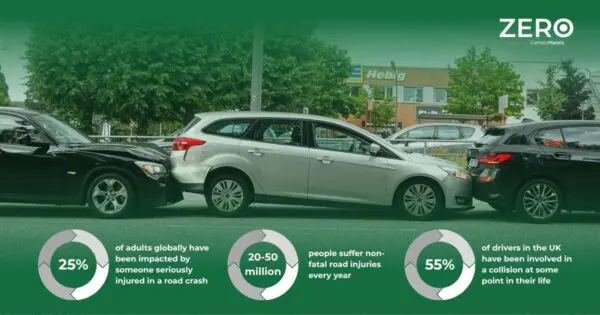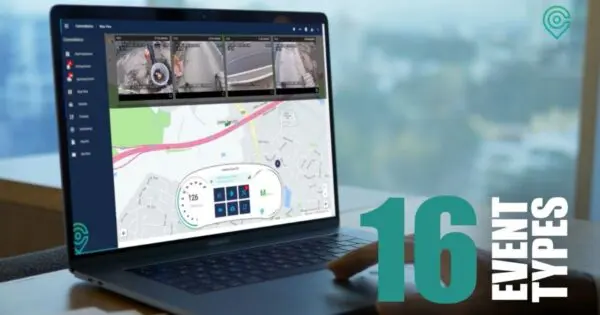The winter months bring icy roads, heavy snow, freezing temperatures, and shorter daylight hours — all of which are extremely challenging for teams that spend a lot of time on the roads. Commercial vehicles face higher risks in these conditions but with proper preparation, your drivers can stay safe, your vehicles can run efficiently, and operations can continue smoothly throughout the season.
Proactive preparation is key for winter conditions – anticipating potential hazards and taking steps to protect both your drivers and your fleet.
How winter conditions affect roads — and your vehicles
Winter driving challenges arise from a combination of road conditions, weather, and how vehicles respond to the cold. Ice, snow, and slush reduce traction and dramatically increase stopping distances — vans can take up to ten times longer to stop, and larger trucks even more. Black ice on the road adds another layer of danger, forming invisibly overnight or in shaded areas, while heavy snowfall and storms reduce visibility, making it harder to see hazards ahead.
Cold weather also affects how vehicles perform in several ways. Tires lose pressure and traction, reducing grip on icy or snowy surfaces. Engines can take longer to reach optimal operating temperature, which can affect acceleration and fuel efficiency. Braking distances increase, and acceleration and cornering may feel less responsive compared to milder conditions.
Even the most experienced drivers can find these driving conditions difficult, which is why preparation and awareness is essential. By understanding how winter conditions impact both the road and the vehicle, fleet managers and drivers can anticipate risks, adjust driving behaviors, and maintain safer control throughout the season.
How to winterize your vehicles
Tires: your connection to the road
Tires are the connection between the road and the vehicle, making them one of the most critical components for safe driving during winter. Knowing when you should put winter tires on your vehicle is essential: for commercial vehicles, top-rated winter tires should be fitted before temperatures consistently drop below 7°C.
And let’s not forget that larger vehicles require tires are rated for heavy loads to maintain traction and control. Regularly checking tire pressure in cold weather is equally important, as low temperatures can reduce pressure and increase stopping distances. Adequate tread depth helps vehicles grip snow, slush, and ice, keeping drivers safe and in control.
Batteries, engines, and fluids: essential winter checks
Winter conditions put extra strain on batteries and engines. Fleet managers should ensure batteries are healthy, with good charge capacity and clean terminals, while electric vehicles benefit from pre-conditioning to preserve range and performance in sub-zero temperatures. Obviously, it goes without saying that all essential fluids — including antifreeze, brake fluid, and oil — should be topped up to keep vehicles running reliably throughout the season.
Visibility: lights and wipers
Maintaining visibility is just as important as preparing the vehicle. Make sure headlights, indicators, and brake lights are fully functional, and that wipers can clear snow and ice effectively. Heating and defrosting systems should be working as normal, and winter windshield washer fluid with anti-freeze should be filled to keep a clear view of the road ahead. Drivers also need to understand when to use – and not use – fog lights to stay visible in heavy snow or poor conditions.
Putting it all together
By combining careful vehicle preparation, proper tire selection, and clear visibility checks, fleet managers can reduce winter-related risks, protect vehicles, and ensure drivers remain safe — while keeping operations running smoothly no matter the weather.
Pack a winter storm survival kit
Even the most prepared vehicles can run into unexpected challenges in winter. Any vehicle that spends a lot of time out on the road should carry a winter storm survival kit to help keep drivers safe and minimize disruption.
What to include in your kit:
A practical kit should cover the essentials for warmth, safety, and emergencies:
- Blanket, warm clothing, gloves, and boots
- Ice scraper and small shovel
- Torch or flashlight
- Snacks and water
- Phone charger and hazard triangle
- Jumper cables / battery pack,
- First-aid kit
- Snow chains (if your location requires it)
- Basic tool kit
Why it matters
Having a winter storm survival kit ensures that both drivers and vehicles are protected if they break down or get caught in a storm.
Drivers are safe, warm, and have the supplies they need and for minor issues, the right tools and equipment can help get the vehicle back on track. Being prepared keeps minor setbacks from turning into serious safety or operational risks.
Adjusting driving habits for winter
How a vehicle is driven can be just as important as how it’s prepared. On icy roads, stopping distances for trucks and vans can be up to ten times longer, so reducing speed and increasing following distance is essential. Smooth, controlled movements — gentle acceleration, braking, and steering — help prevent skidding and maintain control.
Using lower gears in manual vehicles, or if available, engaging “winter mode” in automatics, improves traction in snow and ice. Planning ahead is just as important: checking weather forecasts, road conditions, and potential hazards before departure helps fleet managers make safer routing decisions.
For commercial drivers, evenly distributed and properly secured cargo is critical. Uneven loads can affect handling, particularly in slippery conditions, and increase the risk of accidents.
Using technology to stay winter-ready
Monitoring tires, fluids, and driving habits is essential—but managing it across an entire fleet can be challenging. Technology makes it easier.
CameraMatics provides fleet managers with real-time insights into vehicle health, driver behavior, and route conditions. With features like live vehicle updates, predictive maintenance, GPS tracking, dynamic routing, and in-cab cameras, you can identify issues early, support your drivers, and keep operations running safely and efficiently, even in the harshest winter conditions. Don’t let winter slow you down—see how CameraMatics can protect your fleet today.








